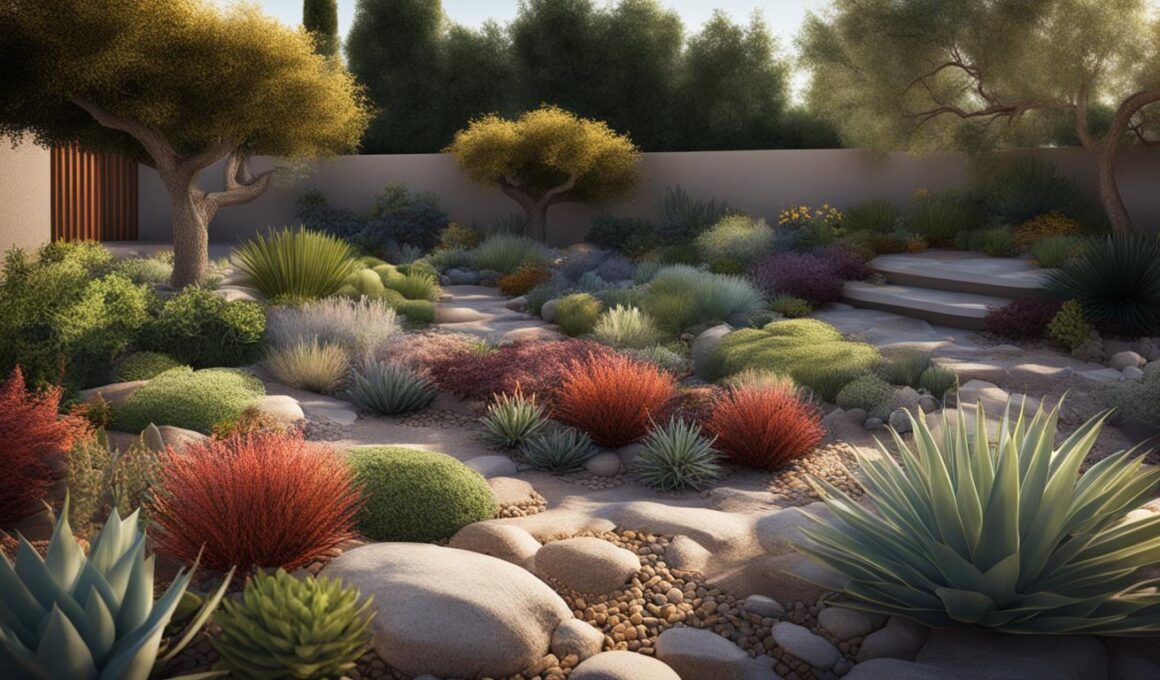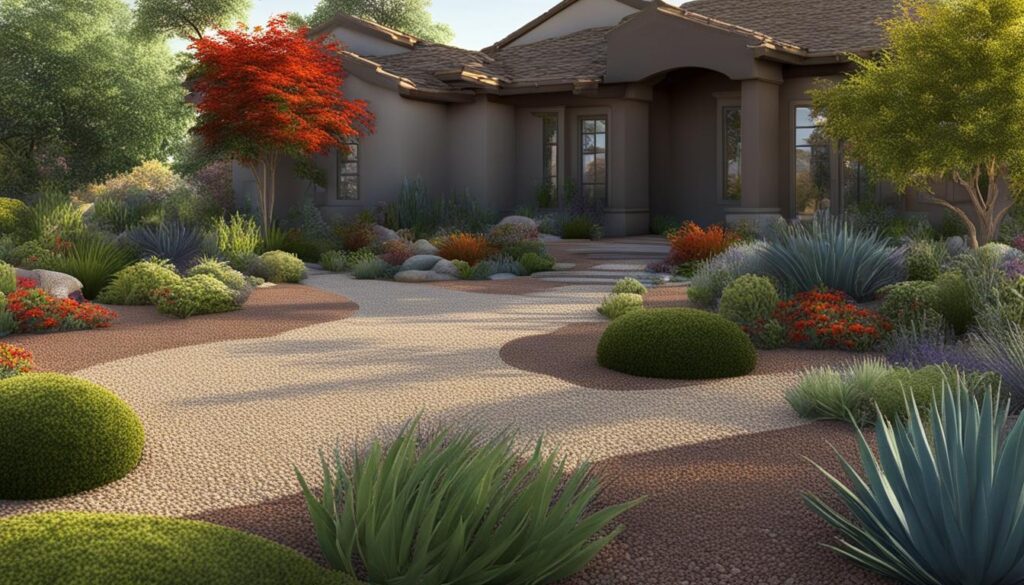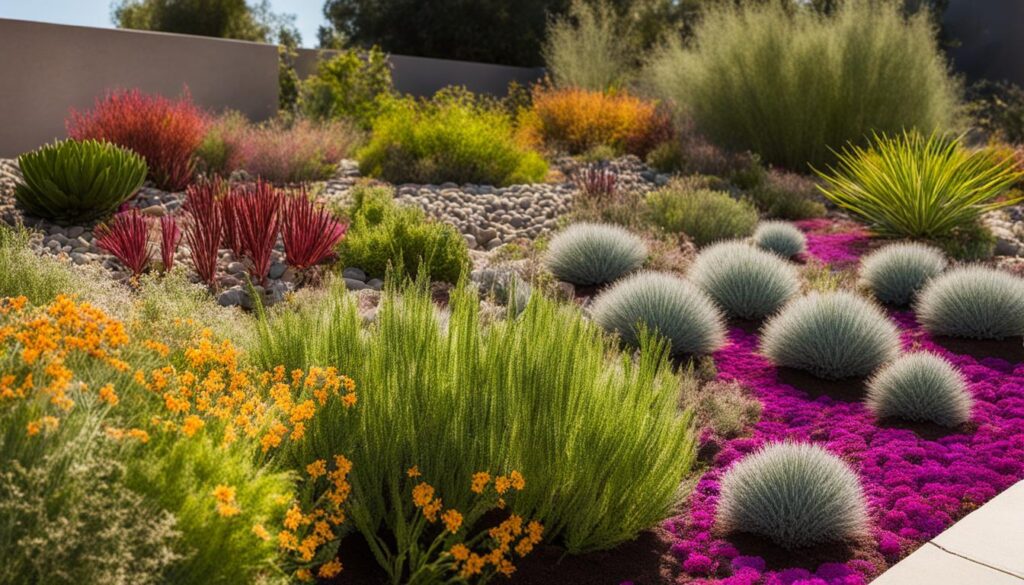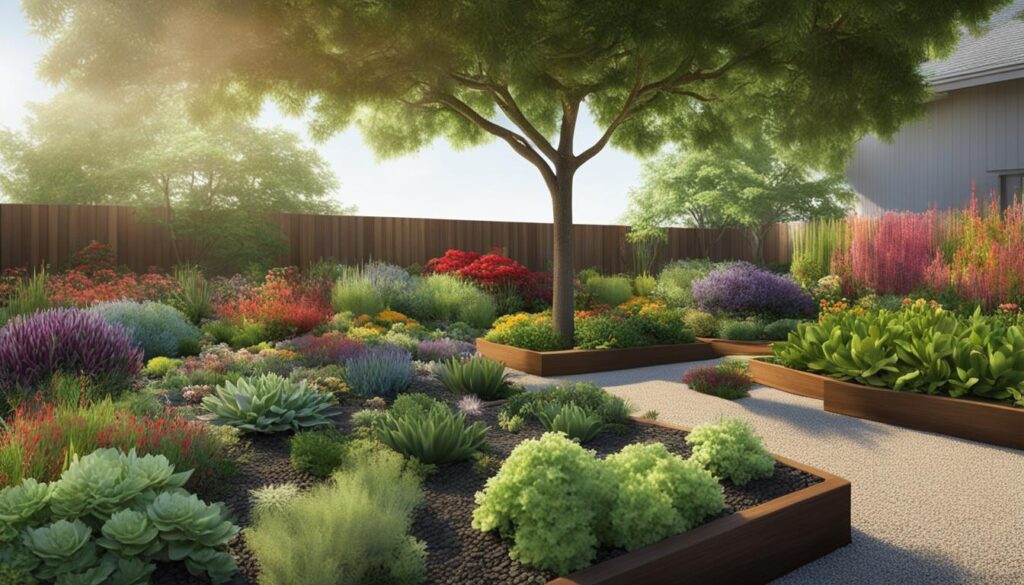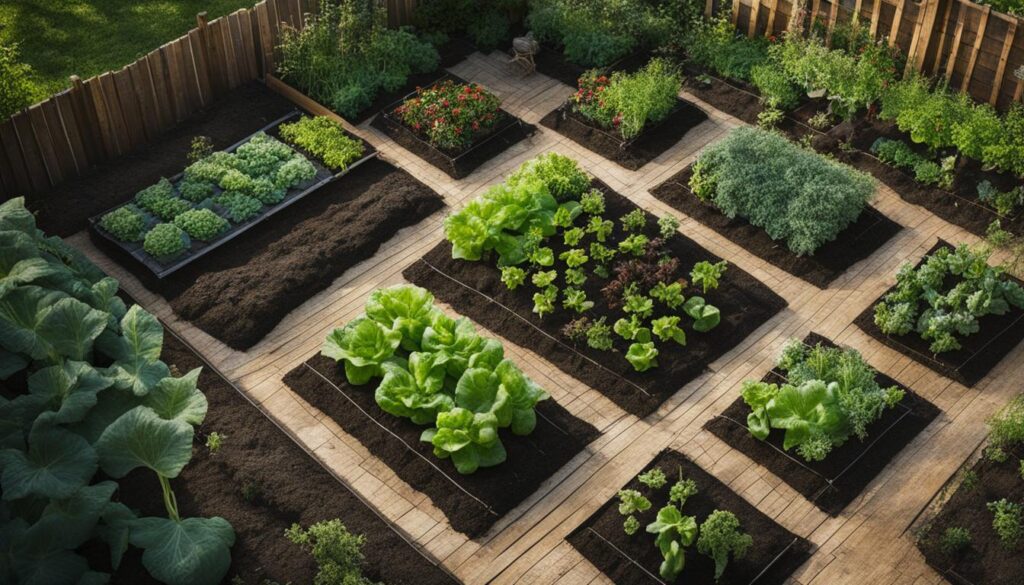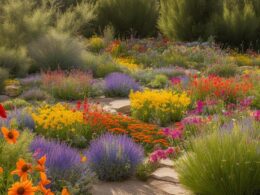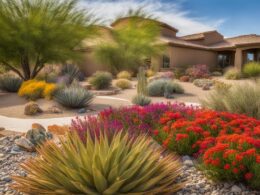Xeriscaping is a landscaping approach that focuses on water conservation as a major objective. Planning is crucial in xeriscaping, taking into consideration factors such as site exposure and slope of the property. Proper soil preparation is essential for water conservation, as different soils have different water-holding capacities. Implementing proper irrigation practices and using organic mulches can also contribute to water savings of 30 to 80 percent.
Key Takeaways:
- Proper planning is essential in xeriscaping to reduce water use.
- Choosing plants adapted to reduced water use and avoiding excessive use of gravel and plastic can help save water.
- Proper soil amendment creates a balanced soil composition that conserves moisture.
- Efficient irrigation practices and system design can lead to significant water savings.
- Mulching is an effective technique for reducing water use and inhibiting weed growth.
The Importance of Proper Planning in Xeriscaping
Proper planning is crucial in xeriscaping to ensure the success of your water-efficient garden. Taking into consideration factors such as site exposure and the slope of your property is essential for reducing water losses and promoting optimal plant growth. By carefully planning your xeriscape, you can create a beautiful and sustainable landscape that conserves water and supports the health of your plants.
Site exposure refers to the amount of sun or shade a particular area of your garden receives. It is important to assess the exposure of different areas of your yard before selecting and placing plants. For example, plants that require full sun should be placed in areas with maximum exposure to sunlight, while shade-loving plants should be located in areas with partial or full shade. By choosing plants that are well-suited to the amount of sunlight they receive, you can ensure their vitality and reduce water requirements.
The slope of your property also plays a significant role in water management in xeriscaping. Areas with steep slopes may experience increased water runoff, leading to water wastage and potential soil erosion. Consider using terracing techniques or creating retention areas to capture and retain water in these areas. Additionally, the slope of your property can affect how water is distributed throughout your landscape. By strategically planning the placement of plants and irrigation systems, you can ensure that water is efficiently distributed and utilized by your plants.
“Proper planning is crucial in xeriscaping to ensure the success of your water-efficient garden.”
Proper planning is the foundation of a water-efficient garden. By considering factors such as site exposure and the slope of your property, you can make informed decisions regarding plant selection and placement, reducing water losses and promoting the overall health of your landscape.
| Factor | Considerations |
|---|---|
| Site Exposure | Assess the amount of sunlight or shade different areas of your garden receive. Choose plants accordingly. |
| Slope of Property | Consider water runoff and potential soil erosion on slopes. Implement terracing or retention techniques. |
Soil Amendment for Water Conservation
Proper soil preparation plays a crucial role in water conservation for xeriscaping. Different soil types have varying water-holding capacities, which can affect the ability of plants to access and utilize water efficiently. By amending the soil, you can create a balanced composition that promotes moisture retention and reduces the need for frequent watering.
Two main types of soil, sandy and clay, have distinct characteristics that require specific amendments. Sandy soil drains water rapidly, resulting in quick water loss, while clay soil repels surface water, making it difficult for plants to access moisture. By addressing these issues, you can optimize your soil for water conservation and plant health.
Amending Sandy Soil
For sandy soil, the addition of organic matter is essential. This could include compost, well-rotted manure, or peat moss. These organic materials improve water retention by increasing the soil’s ability to hold moisture. Additionally, they enhance the soil’s structure, promoting a healthier root system and overall plant growth.
Amending Clay Soil
For clay soil, the addition of organic matter is also beneficial, but it is important to strike a balance. Too much organic matter can exacerbate waterlogging and hinder drainage, so be mindful of the quantities you add. Incorporating coarse sand or perlite can help improve drainage, allowing water to penetrate the soil more effectively.
Regularly incorporating organic matter into your soil, either by adding it directly or through the use of cover crops, can promote long-term soil health and water conservation. Remember to assess your soil’s composition and make amendments accordingly to create optimal conditions for your xeriscape garden.
Efficient Irrigation Practices
Efficient irrigation practices are essential for conserving water in your xeriscape garden. By optimizing your irrigation system design and making smart choices in watering techniques, you can achieve significant water savings while ensuring that your plants receive the moisture they need.
One important step in efficient irrigation is conducting regular audits of your sprinkler system. Inspect your sprinkler heads to make sure they are functioning properly and not leaking. Adjust the sprinkler heads to ensure that they are providing even coverage and not wasting water on sidewalks or driveways. By making these simple adjustments, you can prevent water waste and save on your water bill.
Another strategy for efficient irrigation is to use drip irrigation or strategically placed hoses. These methods deliver water directly to the root zone of plants, reducing evaporation and minimizing water loss. Drip irrigation can be especially effective for watering shrubs and trees, as it allows for precise and targeted irrigation.
The Benefits of Efficient Irrigation
Implementing efficient irrigation practices offers several benefits beyond water savings. It can help foster healthier plant growth by ensuring that water is delivered where it is needed most. This targeted watering approach can also reduce weed growth, as water is not wasted on areas where weeds are unwanted.
By coordinating your landscape design with your irrigation system, you can create a water-saving scheme that promotes the overall health and sustainability of your garden. Grouping plants with similar water needs together and avoiding overwatering can further enhance the effectiveness of your irrigation practices.
| Efficient Irrigation Tips | Benefits |
|---|---|
| Conduct regular audits of sprinkler systems | Prevent water waste and save on water bills |
| Use drip irrigation or strategically placed hoses | Minimize water loss and deliver water directly to the root zone |
| Coordinate landscape design with irrigation system | Create a water-saving scheme and promote overall garden health |
| Group plants with similar water needs together | Enhance the effectiveness of irrigation practices and reduce overwatering |
Implementing efficient irrigation practices not only helps conserve water but also contributes to the long-term sustainability of your xeriscape garden. By making smart choices in your irrigation system design and watering techniques, you can create a beautiful and water-efficient landscape.
Mulching for Water Conservation
One effective technique for reducing water use in your garden is mulching. Mulching involves applying a layer of organic or inorganic material to the soil surface around plants to help retain moisture, suppress weeds, and improve soil conditions. By using mulch, you can save water, reduce the need for frequent watering, and promote a healthy and thriving garden.
Organic mulches, such as wood chips, compost, or straw, are excellent choices for water retention. They create a protective layer that helps to prevent evaporation, keeping the soil moist for longer periods. This is especially beneficial during hot and dry weather conditions when water loss is more pronounced. In addition to water conservation, organic mulches also contribute to soil health and fertility as they gradually break down, releasing nutrients into the soil.
“Mulching is a valuable practice in water-efficient gardening. It acts as a barrier that reduces evaporation, minimizes weed growth, and moderates soil temperatures. By using organic mulches, you can create a healthier and more sustainable garden.”
Inorganic mulches, like gravel or stone, provide the same benefits as organic mulches but with a different approach. They allow for water and air exchange, reducing the risk of soil compaction while still retaining moisture. Inorganic mulches are particularly suitable for areas where water drainage is a concern, preventing soil erosion and water runoff.
To effectively mulch your garden, apply a layer of mulch about 2 to 4 inches thick around your plants, making sure to leave space around the stems or trunks to avoid excessive moisture buildup. Regularly monitor the moisture levels in the soil and adjust watering accordingly. Mulch should be replenished as needed to maintain the desired depth and effectiveness.
Benefits of Mulching for Water Conservation
- Reduces water evaporation from the soil surface
- Maintains soil moisture for longer periods
- Suppresses weed growth and competition for water
- Improves soil structure and fertility
- Protects plants from extreme temperatures
Using mulch in your garden is a simple and effective way to conserve water and promote a healthier and more sustainable landscape. Whether you choose organic or inorganic mulches, applying a layer of mulch around your plants will help you achieve water savings while creating a beautiful and thriving garden.
| Mulch Type | Water Retention | Weed Inhibition | Soil Improvement |
|---|---|---|---|
| Organic Mulch (e.g., wood chips, compost, straw) | High | High | High (as they break down) |
| Inorganic Mulch (e.g., gravel, stone) | Moderate | High | Moderate |
Selecting the Right Plants
Choosing the right plants is a crucial step in creating a water-efficient landscape. When selecting plants for your xeriscape garden, consider their water needs, compatibility with the soil, and ability to thrive in your specific climate. By choosing plants that are well-adapted to reduced water use, you can significantly reduce water consumption in your garden.
Water Needs
It’s important to choose plants that have low water requirements and can thrive in your local climate. Native plants are often a great choice because they are naturally adapted to the local environment and can survive with minimal irrigation. Look for plants labeled as drought-tolerant or water-wise, as these are specifically selected for their ability to thrive in arid conditions.
Compatible Soil
In addition to water needs, it’s essential to consider the compatibility of plants with the soil in your garden. Different plants have different soil requirements, so it’s important to select plants that are well-suited to your soil type. Factors such as soil pH, drainage, and nutrient content can impact a plant’s ability to absorb water efficiently. Conduct a soil test to determine the composition of your soil and choose plants that can thrive in those conditions.
“Choosing plants that are well-adapted to reduced water use can significantly reduce water consumption in your garden.”
Grouping Plants with Similar Water Requirements
To optimize water use in your xeriscape garden, consider grouping plants with similar water requirements together. This allows you to water different areas of your garden more efficiently, ensuring that each plant receives the appropriate amount of water. By grouping plants with similar needs, you can avoid overwatering some plants while underwatering others.
A well-designed xeriscape garden not only reduces water consumption but also creates a beautiful and sustainable landscape. By carefully selecting plants that have low water needs, are compatible with your soil, and can thrive in your climate, you can create a water-efficient garden that is both visually appealing and environmentally responsible.
Maintenance of a Water-Efficient Landscape
Creating a water-efficient landscape not only helps conserve water but also minimizes the need for extensive maintenance. By following a few simple practices, you can enjoy a beautiful garden while reducing your workload. Here are some low maintenance gardening tips to keep your water-efficient landscape thriving:
Proper Lawn Care:
One of the key aspects of maintaining a water-efficient landscape is taking care of your lawn. Deep watering is essential to encourage deep root growth and reduce the frequency of watering. Instead of frequent shallow watering, water your lawn deeply once a week, allowing the water to penetrate the soil. Additionally, leaving grass clippings on the lawn can act as a natural fertilizer, reducing the need for additional feeding.
Composting:
Composting is an effective way to improve soil health and reduce the need for excessive watering. By adding organic matter to your soil, you enhance its ability to retain moisture, reducing water loss through evaporation. Apply a layer of compost annually and work it into the soil to promote healthy plant growth and conserve water.
“Composting is a natural way to nourish your soil and reduce water usage in your garden. It not only enhances soil structure but also supports the overall health of your plants.” – Gardening Expert
Reducing Watering Over Time:
Initially, newly planted landscapes may require regular watering to establish their root systems. However, as plants mature and become established, you can gradually reduce the frequency of watering. Monitor the moisture levels in your soil and adjust your watering schedule accordingly. By gradually reducing watering, you encourage plants to develop deep root systems that are better equipped to withstand periods of drought.
Implementing these low maintenance gardening practices will not only conserve water but also save you time and effort in maintaining your water-efficient landscape. With proper lawn care, composting, and reduced watering over time, you can enjoy a beautiful garden that thrives with minimal maintenance.
| Low Maintenance Gardening Tips |
|---|
| Water your lawn deeply once a week to encourage deep root growth. |
| Leave grass clippings on the lawn to act as a natural fertilizer. |
| Add compost annually to improve soil moisture retention. |
| Gradually reduce watering as plants mature and become established. |
Maximizing Vegetable Garden Space
Your vegetable garden is a valuable space that can be optimized to maximize productivity and water efficiency. By implementing techniques such as interplanting, companion planting, and succession planting, you can make the most of limited garden area and enjoy a bountiful harvest throughout the growing season.
Interplanting involves planting different vegetable species in the same space, allowing you to grow more crops in a smaller area. For example, you can interplant fast-growing crops like radishes or lettuce between rows of slower-growing vegetables such as tomatoes or peppers. This technique not only maximizes your garden space but also helps deter pests by confusing them with a diverse array of plants.
Companion planting is another strategy that can enhance the productivity of your vegetable garden. Certain plants have natural affinities for each other, and when grown together, they can provide mutual benefits. For instance, planting marigolds alongside tomatoes can help repel harmful insects, while basil planted near tomatoes can improve their flavor and deter pests. By carefully selecting compatible plant combinations, you can create a harmonious and thriving garden ecosystem.
“Succession planting is a clever technique that allows you to harvest crops continuously throughout the growing season.”
Succession planting is a clever technique that allows you to harvest crops continuously throughout the growing season. Instead of planting your entire vegetable garden at once, stagger your plantings so that mature plants are harvested while new ones are sown. This way, you can enjoy a steady supply of fresh vegetables without overwhelming your kitchen with a sudden abundance. Succession planting also helps optimize water usage by ensuring that plants are in different stages of growth, reducing the demand for irrigation.
By incorporating interplanting, companion planting, and succession planting into your vegetable garden, you can make the most of your space while conserving water. These techniques not only promote efficient use of resources but also create a diverse and vibrant garden that rewards you with a variety of delicious, homegrown vegetables.
Interplanting, Companion Planting, and Succession Planting Tips:
- Choose vegetable species that have similar growth requirements, such as sun exposure, water needs, and soil preferences when interplanting.
- Research and experiment with companion planting to find combinations that work well together, considering factors such as pest control, nutrient exchange, and plant growth stimulation.
- When succession planting, keep a calendar or journal to track planting and harvesting dates, ensuring a continuous supply of fresh vegetables.
- Consider combining interplanting, companion planting, and succession planting techniques for even greater efficiency and productivity in your vegetable garden.
How Can I Improve Soil Fertility for Xeriscape Plants?
To enhance xeriscape soil fertility, consider adding organic matter such as compost or manure. Use mulch to retain moisture and reduce erosion. Choose native plants suited to low-water environments. Rotate crops to prevent nutrient depletion. Finally, test your soil regularly to monitor its pH and nutrient levels. These xeriscape soil fertility improvement tips can help create a thriving, low-maintenance garden.
Conclusion
In conclusion, implementing water-efficient gardening practices, such as xeriscaping, can bring numerous benefits to your landscape. By following a few simple steps, you can significantly reduce water usage, lower maintenance needs, and create a thriving and sustainable garden.
First and foremost, proper planning is essential. Consider factors like site exposure and slope of the property to determine the best layout for your water-efficient garden. Select plants that are adapted to reduced water use and group them according to their water needs, optimizing water efficiency.
Soil amendment is another crucial aspect. Prepare your soil by adding organic matter annually and deep within the soil. This will create a balanced soil composition that supports healthy plant life, conserves moisture, and reduces the need for frequent watering.
Efficient irrigation practices play a vital role in water conservation. Regularly audit your sprinkler system and adjust it to avoid water waste. Consider using drip irrigation or strategically placed hoses for improved water efficiency. By coordinating your landscape design with your irrigation system, you can ensure a sensible and water-saving scheme.
Mulching is an effective technique for reducing water use. Organic mulches, like wood chips and compost, help maintain soil moisture and improve soil conditions. Inorganic mulches, such as gravel, allow for water and air exchange. Proper mulching also inhibits weed growth, minimizing the need for additional watering.
With xeriscaping and water-efficient gardening practices, you can enjoy a beautiful and sustainable landscape while conserving water and reducing maintenance requirements. By implementing these strategies, you’ll create a thriving garden that benefits both your environment and your enjoyment.





